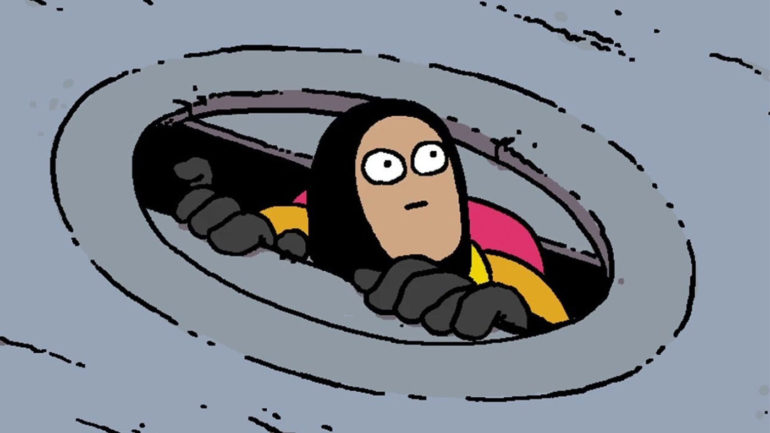Kitty Calis and Jan Willem Njiman (perhaps better known as J.W.) both have an impressive pedigree when it comes to game development, with Kitty’s body of work including Horizon: Zero Dawn and Jan’s stretching back to indie hits such as Luftrausers and Super Crate Box.
The two banded together to bring us Minit, a strange little Legend of Zelda-inspired adventure game played in sixty-second increments. Though it shouldn’t come as a surprise that Minit was a massive subversion of expectations, as much of the industry’s innovation stems from the indie space, the fact they’ve backed it up again with Disc Room is an achievement.
With Disc Room only a couple of days away from release, we were fortunate enough to have a chat with part of the tight-knit team behind the game and we spoke about inclusivity, the joy of discovery, and whether or not they’re the best game ever to feature saw blades.
(Spoiler: They’re too modest.)
Like Minit before it, Disc Room appears to be, on the surface, a basic concept. Playing it is a mind-opening realisation that there’s plenty going on subsurface, is this a deliberate deception of sorts to surprise the player and keep them guessing?
JW: There sure is a lot to it. I think Dose, Kitty, Terri, and I all share some common ideas about game design: Just because a game is challenging, doesn’t mean it should be hard to play. Disc Room uses just one button and a stick, it throws you right into the game without any barriers.
Like our favorite sci-fi movies, there’s something to be said about the mystery of it all. There’s more to it than there seems to be at first glance, and instead of spelling everything out, the player gradually uncovers these depths. Discovery is a huge part of the fun!
Despite the game’s almost crudely drawn visuals, there’s a great sense of atmosphere and tone that’s constantly emitting from this alien disc ship. What sci-fi did you look at as inspiration?
Kitty: Atmosphere is key! If you think about it for a second, Disc Room has a ridiculous premise: A giant disc appears in space, filled with rooms, filled with sawblades.
Think classic and cheesy, from 2001: A Space Odyssey to Rendezvous with Rama to Logan’s Run and Cube, inspiration really is everywhere. That feeling of exploring an alien space, where everything is dangerous, strange and you don’t know what to expect is just too good.
Where’d the idea for these deeply puzzling gold rooms stem from? It’s almost as if it implies reverence for a higher power within this community of sentient killer discs.
Kitty: This follows up. A giant disc appearing next to Jupiter poses one big question: Why? No spoilers, but there’s a deeper layer and larger mystery for the player to figure out.
On that, why exactly did you opt for discs as a nemesis?
JW: When starting out on the project, Kitty, Terri, Dose and I always said we wanted to make something very simple, yet interesting. If you think about it, a bouncing saw blade is the most simple enemy you can add to a game right after spikes.
We wanted to challenge ourselves and see if we could get a whole game out of that. And it turns out you can! Combining that with our love for sci-fi just kept on inspiring. In a way, limitations are a great boost to creativity.
Although Disc Room as an idea has been floating about for a number of years now, which games inspired its original inception? Is there a soft spot internally for tough, ‘bang your head against a wall’ games like I Wanna Be The Guy, or was it born more out of a love for retro shmups?
Kitty: All of those things are big factors, including more minimalist game design. I love bullet hell games getting you right “in the zone”, and there’s something about the instant button press to respawn in super difficult platformers. VVVVVV was a pretty big influence there, in how it marries together super short challenges with a larger world to explore.
There are some similarities to Super Meat Boy in terms of being tremendously tough games, but would you say you’re now the best game on the market which features saw blades?
JW: I definitely don’t want to say we’re the best game with saw blades – that honor goes to Unreal Tournament 98. But I do think we’re a contender for the game with the most saw blades!
There are some wild monster designs in Disc Room, from gravity well discs right through to discs made of teeth and flesh. Were there any particularly odd designs that didn’t make the final game?
Kitty: Hmm, good question. This game was the best blank canvas to throw ideas and inspirations into. But as with any project, sometimes ideas just don’t work. The final Gatekeeper is one we tried making four times from scratch before landing on the version that’s in the game now.
While designing Disc Room, often the answer was less is more, or so the saying goes. But in the end, more is also more, as was the case with this final end boss!
Again, just like Minit, I feel Disc Room sucks the player into its addictive loop, though it’s also suited for short bursts. Is this the reason behind it launching on Switch before exploring other console ports, assuming they’re hopefully over the horizon?
Kitty: We’re a small team, so it makes sense to focus on a smaller number of platforms first, and Switch just seemed like a great place for something like this! It’s definitely a game that you can play either in short bursts or just binge on to beat your friend’s high score.
I particularly admire your team’s effort to add sliders so that people who might have difficulty with gaming can set their own difficulty standards. Obviously, this was a conscious effort to be inclusive, do you think developers do enough to cater to the less-abled?
JW: There’s definitely a trend leading towards this in difficult games, looking at titles like Celeste or VVVVVV. In the end, every player is different, so you can’t ever fine-tune something on one setting for your entire audience. We see no reason not to make an experience that can cater to a wide variety of difficulties and players.
Likewise, there are various points throughout Disc Room where you can ramp up the challenge. Some people might complete the story and feel really satisfied to stop there, while other people want to dive straight into hard mode, play at 200% speed, or even try some of the ultra-difficult challenges we have waiting within the menu.
We believe that everyone should be able to get a disc to the face at their own pace.
During my time with Disc Room, I managed to survive 10 seconds on every hard level, but that didn’t give me as much satisfaction as chasing down a few of your team’s times. Do you think the competitive aspect and speedrunning will help build a dedicated, hardcore fanbase?
JW: That’s impressive! We sure hope so. We’re really happy to have included our own scores as “dev times”, it’s a fun way to get people started on playing for high scores. People will start beating us pretty quickly, so then you’ll have your friend scores to worry about! We do hope that speedrunners seek it out, like with Minit. There’s a bunch of interesting shortcuts in place, and it’s definitely something we’ve thought about from the start of development.
From talking with Carrion’s Krzysztof Chomicki I got the sense that Devolver Digital is super easy to collaborate with. Based on your work on Minit and now Disc Room, how have you found them?
Kitty: They are a bunch of beauties! Devolver trusts their developers and takes care of everything that isn’t making the game. And let’s just say, not every publisher jumps to publish a game where the pitch is: “The year is 2089 and there are rooms with sawblades. Lots of sawblades”.
How did the collaboration with Doseone come about? Is it a case of synergising between Devolver properties after his work on Enter the Gungeon or did you seek him out yourselves?
JW: I’ve personally worked with Dose for a while now, starting with Gun Godz back in 2012, which I believe was his introduction to indie games. Following this Kitty and I jammed with him a few times over the years, and Terri and Dose became a game dev power couple. We’ve all been friends ever since, and Disc Room was the perfect opportunity to all dive in together!
So Kitty, before working on Minit and Disc Room you were a producer on Horizon: Zero Dawn, which feels like a real apples and oranges situation with regards to all facets of the development process. From workload to a sense of reward they both must differ in ways people might not expect. Of the two environments, which do you prefer and which do you think gets your creative juices flowing more?
Kitty: Right now I’m having a great time with the team, it’s been the total opposite, which is really fun! Both Minit and Disc room are made by just a few folks, which made it easier to experiment, while on Horizon it’s all bigger teams and workflows.
Think multiple departments to help style and mock-up, not to mention program and design areas that are carefully thought through. It’s important to understand your design limitations and be familiar with the size and scale of the game.
Thank you both for your time.
Disc Room releases for PC and Nintendo Switch on October 24.



